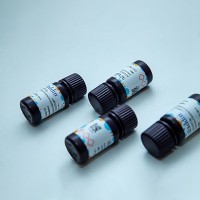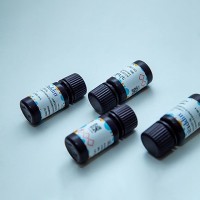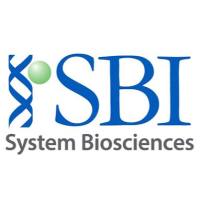Functional Assays on High‐Content Protein Microarrays
互联网
- Abstract
- Table of Contents
- Materials
- Figures
- Literature Cited
Abstract
High?content functional protein microarrays, such as ProtoArray Human Protein Array from Life Technologies, contain thousands of proteins or protein fragments of biological significance. Based on this platform, numerous assays have been developed to investigate protein?protein interactions, protein?DNA interactions, protein?phospholipid interactions, small?molecule targets, substrates of protein kinases, substrates of ubiquitin E3 ligases, and substrates of methyltransferase. This article provides a detailed illustration of the general procedure for setting up functional assays for high?throughput screening and also provides guidelines for data analysis. The protocols include the use of fluorescently labeled and radioactive probes for detection. Curr. Protoc. Chem. Biol. 4:211?231 © 2012 by John Wiley & Sons, Inc.
Keywords: high content protein microarray; functional assays; protein?protein interaction; small?molecule interaction; kinase substrate profiling; ubiquitin ligase substrate profiling; protein methyltransferase substrate profiling
Table of Contents
- Introduction
- Strategic Planning
- Basic Protocol 1: Protein‐Protein Interaction (PPI) Assay on the ProtoArray Human Protein Array
- Basic Protocol 2: Small‐Molecule Interaction (SMI Radioactive) Assay on the ProtoArray Human Protein Array
- Basic Protocol 3: Kinase Substrate Identification (KSI) Assay on the ProtoArray Human Protein Array
- Basic Protocol 4: Ubiquitin/SUMO Ligase Substrate Profiling Assay on the ProtoArray Human Protein Array
- Basic Protocol 5: Methyltransferase Profiling Assay on the ProtoArray Human Protein Array
- Reagents and Solutions
- Commentary
- Literature Cited
- Figures
Materials
Basic Protocol 1: Protein‐Protein Interaction (PPI) Assay on the ProtoArray Human Protein Array
Materials
Basic Protocol 2: Small‐Molecule Interaction (SMI Radioactive) Assay on the ProtoArray Human Protein Array
Materials
Basic Protocol 3: Kinase Substrate Identification (KSI) Assay on the ProtoArray Human Protein Array
Materials
Basic Protocol 4: Ubiquitin/SUMO Ligase Substrate Profiling Assay on the ProtoArray Human Protein Array
Materials
Basic Protocol 5: Methyltransferase Profiling Assay on the ProtoArray Human Protein Array
Materials
|
Figures
-
Figure 1. Anti‐GST image of over 9000 unique human proteins on a ProtoArray human protein microarray. One of the subarrays is enlarged to show the subarray layout. Multiple control proteins are shown. These control proteins help to orient the array grid in the data analysis step and serve as positive and negative controls for different applications. View Image -
Figure 2. Schematic of the ubiquitin ligase profiling workflow. A typical assay involves probing five arrays. Three of the arrays are probed with E3 ligases at three different concentrations. The other two arrays are negative controls which are probed with biotin‐ubiquitin only or biotin‐ubiquitin plus E1 and E2 ligases. View Image -
Figure 3. CMK1 protein‐protein interaction assay. A ProtoArray image probed with V5‐CMK1 shows the interaction of calmodulin with V5‐CMK1. The positive control, V5 control protein, is also detected by the anti‐V5 antibody. *The calmodulin signals did not show up on the negative array (data not shown). View Image -
Figure 4. MAPK14/ p38γ kinase substrate identification assay. The ATP‐only treatment of the ProtoArray shows the autophosphorylation of many printed kinases. In comparison, the MAPK14/p38γ–reated array shows additional phosphorylation spots, such as the inactive MAPKAP kinase in the enlarged region. View Image -
Figure 5. PRMT1 methyltransferase profiling assay. The image of the ProtoArray treated with PRMT1 shows some methylation spots, such as SERBP1 and C1orf77 in the enlarged region. Both proteins are known substrates of PRMT1. In this array image, ERα spots also show up since the array was also treated with 3 H[estradiol]. The ERα spots are landmarks for data acquisition. View Image
Videos
Literature Cited
| Colca, J.R. and Harrigan, G.G. 2004. Photo‐affinity labeling strategies in identifying the protein ligands of bioactive small molecules: Examples of targeted synthesis of drug analog photoprobes. Comb. Chem. High Throughput Screen. 7:699‐704. | |
| Foster, M.W., Forrester, M.T., and Stamler, J.S., 2009. A protein microarray‐based analysis of S‐nitrosylation. Proc. Natl. Acad. Sci. U.S.A. 106:18948‐18953. | |
| Huang, J., Zhu, H., Haggarty, S.J., Spring, D.R., Hwang, H., Jin, F., Snyder, M., and Schreiber, S.L. 2004. Finding new components of the target of rapamycin (TOR) signaling network through chemical genetics and proteome chips. Proc. Natl. Acad. Sci. U.S.A. 101:16594‐16599. | |
| Kumble, K.D. 2003. Protein microarrays: New tools for pharmaceutical development. Anal. Bioanal. Chem. 377:812‐819. | |
| Le Roux, S., Devys, A., Girard, C., Harb, J., and Hourmant, M. 2010. Biomarkers for the diagnosis of the stable kidney transplant and chronic transplant injury using theProtoArray reg; technology. Transplant Proc. 42:3475‐3481. | |
| MacBeath, G. and Schreiber, S.L. 2000. Printing proteins as microarrays for high‐throughput function determination. Science 289:1760‐1763. | |
| Manning, G., Whyte, D.B., Martinez, R., Hunter, T., and Sudarsanam, S. 2002. The protein kinase complement of the human genome. Science 298:1912‐1934. | |
| Michaud, G.A., Salcius, M., Zhou, F., Bangham, R., Bonin, J., Guo, H., Snyder, M., Predki, P.F., and Schweitzer, B.I. 2003. Analyzing antibody specificity with whole proteome microarrays. Nat. Biotechnol. 21:1509‐1512. | |
| Miersch, S. and LaBaer, J. 2011. Nucleic acid programmable protein arrays: Versatile tools for array‐based functional protein studies. Curr. Protoc. Prot. Sci. 64:27.2.1‐27.2.26. | |
| Mitsopoulos, G., Walsh, D.P., and Chang, Y.T. 2004. Tagged library approach to chemical genomics and proteomics. Curr. Opin. Chem. Biol. 8:26‐32. | |
| Nalepa, G., Rolfe, M., and Harper, J.W. 2006. Drug discovery in the ubiquitin‐proteasome system. Nat. Rev. Drug Discov. 5:596‐613. | |
| Oláh, J., Vincze, O., Virók, D., Simon, D., Bozsó, Z., Tõkési, N., Horváth, I., Hlavanda, E., Kovács, J., Magyar, A., Szũcs, M., Orosz, F., Penke, B., and Ovádi, J. 2011. Interactions of pathological hallmark proteins: Tubulin polymerization promoting protein/p25, beta‐amyloid, and alpha‐synuclein. J. Biol. Chem. 286:34088‐3100. | |
| Pal, S. and Sif, S. 2007. Interplay between chromatin remodelers and protein arginine methyltransferases. J. Cell. Physiol. 213:306‐315. | |
| Pray, T.R., Parlati, F., Huang, J., Wong, B.R., Payan, D.G., Bennett, M.K., Issakani, S.D., Molineaux, S., and Demo, S.D. 2002. Cell cycle regulatory E3 ubiquitin ligases as anticancer targets. Drug Resist. Update 5:249‐258. | |
| Predki, P.F. 2004. Functional protein microarrays: Ripe for discovery. Curr. Opin. Chem. Biol. 8:8‐13. | |
| Ptacek, J., Devgan, G., Michaud, G., Zhu, H., Zhu, X., Fasolo, J., Guo, H., Jona, G., Breitkreutz, A., Sopko, R., McCartney, R.R., Schmidt, M.C., Rachidi, N., Lee, S.J., Mah, A.S., Meng, L., Stark, M.J., Stern, D.F., De Virgilio, C., Tyers, M., Andrews, B., Gerstein, M., Schweitzer, B., Predki, P.F., and Snyder, M. 2005. Global analysis of protein phosphorylation in yeast. Nature 438:679‐684. | |
| Ramachandran, N., Hainsworth, E., Bhullar, B., Eisenstein, S., Rosen, B., Lau, A.Y., Walter, J.C., and LaBaer, J. 2004. Self‐assembling protein microarrays. Science 305:86‐90. | |
| Ramachandran, N., Larson, D.N., Stark, P.R., Hainsworth, E., and LaBaer, J. 2005. Emerging tools for real‐time label‐free detection of interactions on functional protein microarrays. FEBS J. 272:5412‐5425. | |
| Satoh, J., Obayashi, S., Misawa, T., Sumiyoshi, K., Oosumi, K., and Tabunoki, H. 2009. Protein microarray analysis identifies human cellular prion protein interactors. Neuropathol. Appl. Neurobiol. 35:16‐35. | |
| Schweitzer, B., Predki, P., and Snyder, M. 2003. Microarrays to characterize protein interactions on a whole‐proteome scale. Proteomics 3:2190‐2199. | |
| Singh, J., Salcius, M., Liu, S.W., Staker, B.L., Mishra, R., Thurmond, J., Michaud, G., Mattoon, D.R., Printen, J., Christensen, J., Bjornsson, J.M., Pollok, B.A., Kiledjian, M., Stewart, L., Jarecki, J., and Gurney, M.E. 2008. DcpS as a therapeutic target for spinal muscular atrophy. ACS Chem. Biol. 3:711‐722. | |
| Tang, X., Orlicky, S., Liu, Q., Willems, A., Sicheri, F., and Tyers, M. 2005. Genome‐wide surveys for phosphorylation‐dependent substrates of SCF ubiquitin ligases. Methods Enzymol. 399:433‐458. | |
| Vermeulen, N., de Béeck, K.O., Vermeire, S., Steen, K.V., Michiels, G., Ballet, V., Rutgeerts, P., and Bossuyt, X., 2010. Identification of a novel autoantigen in inflammatory bowel disease by protein microarray. Inflamm. Bowel Dis. 17:1291‐1300. | |
| Yifa, M. and Marc, W.K. 2009. Large‐scale detection of ubiquitination substrates using cell extracts and protein microarrays. Proc. Natl. Acad. Sci. U.S.A. 106:2543‐2548. | |
| Zhu, H., Bilgin, M., Bangham, R., Hall, D., Casamayor, A., Bertone, P., Lan, N., Jansen, R., Bidlingmaier, S., Houfek, T., Mitchell, T., Miller, P., Dean, R.A., Gerstein, M., and Snyder, M. 2001. Global analysis of protein activities using proteome chips. Science 293:2101‐2105. | |
| Internet Resources | |
| http://www.invitrogen.com/site/us/en/home/Products‐and‐Services/Applications/Protein‐Expression‐and‐Analysis/Biomarker‐Discovery/ProtoArray/Human‐Protein‐Microarrays‐Overview.html | |
| Life Technologies. Overview of ProtoArray Human Protein Microarrays. |







